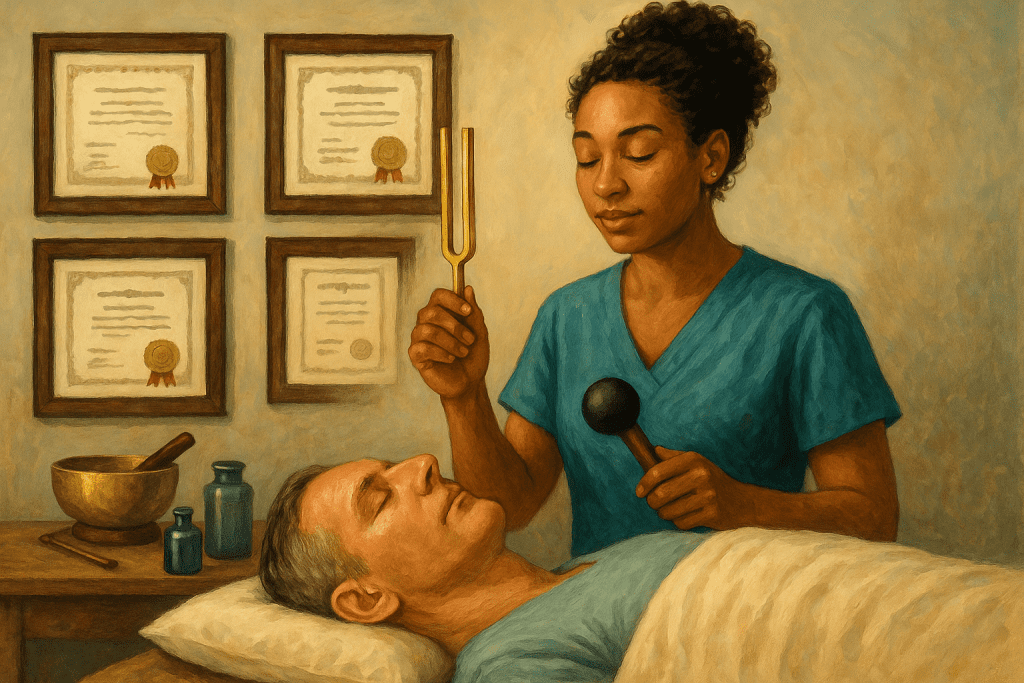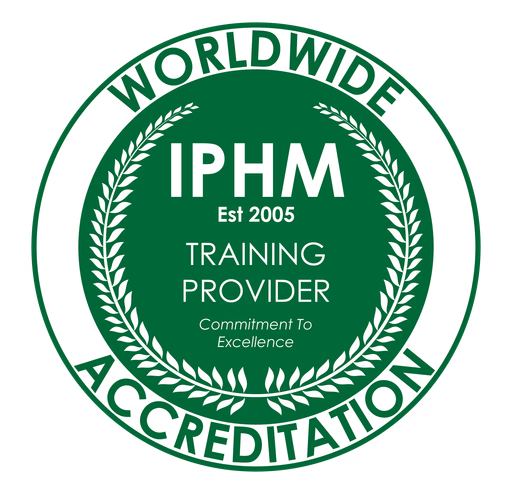
Introduction
Holistic healing is becoming more popular than ever, and sound and vibration therapy sits right at the center of this movement. People are realizing that healing isn’t only about medicine it’s also about balance, energy, and frequency. But here’s the catch: if you want to practice sound and vibration therapy professionally, you’ll need the right certifications. These not only prove your expertise but also give clients the confidence that they’re in safe hands.
Understanding Sound and Vibration Therapy
So, what exactly is sound and vibration therapy? In short, it’s the use of sound frequencies and vibrations to bring harmony to the body and mind. Practitioners may use instruments like singing bowls, tuning forks, drums, or even their voice to create resonant frequencies that can reduce stress, improve energy flow, and support emotional healing.
Certain frequencies and sounds can influence our bodies’ systems by affecting brain waves and working at a cellular level, helping to synchronize natural rhythms and promote relaxation.
The benefits? Many clients report better sleep, reduced anxiety, improved focus, and even relief from chronic pain. These sound vibrations interact with our bodies not just the mind by impacting muscles, organs, and energy fields to promote overall well-being. Science is slowly catching up, but holistic wellness seekers already swear by it.
Types of Sound Healing
Sound healing is a broad field, offering a variety of techniques and experiences to support deep relaxation, balance, and overall well-being. Each approach uses the power of sound vibrations in unique ways to help the body and mind find harmony.
Sound therapy often involves listening to carefully selected tones or frequencies, either live or pre-recorded, to calm the nervous system and promote stress relief. This method can help restore balance and support emotional healing.
Vibrational medicine uses tools like tuning forks, which are placed near or on the body to produce vibrations that stimulate cellular repair and energy flow. These gentle sound waves can help bring the body back into balance and support healing at a deep level.
Music therapy is another popular approach, where specific music tracks are chosen to encourage emotional processing, relaxation, and even pain relief. This technique is often used in clinical settings to support mental health and well-being.
Sound baths immerse participants in a meditative environment filled with resonant sound waves from instruments like crystal singing bowls, Tibetan singing bowls, and gongs. The soothing music and vibrations help reduce anxiety, improve sleep quality, and create a sense of peace.
Other sound healing techniques include guided meditation with sound, tuning fork therapy, neurologic music therapy, vibroacoustic therapy, brainwave entrainment, Nordoff-Robbins music therapy, and the Bonny Method of Guided Imagery and Music (GIM). Each method offers its own set of benefits, from reducing muscle tension to enhancing spiritual well-being.
Whether you’re drawn to the gentle hum of tuning forks or the immersive experience of a sound bath, sound healing provides a range of options to support your journey toward balance and healing.
The Importance of Certification
You might wonder can’t anyone just buy a singing bowl and start offering therapy? Technically yes, but without certification, you’ll struggle to build credibility. Certification proves you’ve studied the techniques, understand client safety, and know how to use these tools effectively.
It’s also about ethics. Certifications ensure practitioners follow proper guidelines, keeping the therapy safe and professional. Plus, in many regions, you’ll need official training to work in wellness centers, spas, or medical collaborations.
Core Certifications for Sound and Vibration Therapists
Certified Sound Therapy Practitioner
This is one of the most common certifications. It covers the basics how to use different instruments, the science of sound healing, client care, and training in conducting a sound healing session.
The main difference between this certification and others is its focus on foundational skills, making it ideal for beginners.
Certified Vibrational Healing Practitioner
This program digs deeper into vibrational frequencies, energy fields, and how vibrations affect the human body. It covers techniques such as binaural beats for brainwave modulation and the use of devices where the machine vibrates to stimulate muscles, promoting muscle contraction and relaxation for enhanced muscular health.
Certification in Music Therapy
Although more clinical, music therapy certification is highly respected. It’s recognized in healthcare settings and requires more academic study, often at the university level. Certification programs often include training in research methods, such as understanding the use of a control group to measure outcomes, and emphasize what research shows about the effectiveness of music therapy.
Reiki and Energy Healing Certifications
Many sound therapists combine their practice with Reiki or other energy healing methods, making sessions more holistic.
Internationally Recognized Certifications
International Sound Healing Academy (ISHA)
Known for its structured global training, ISHA offers both online and in-person courses, from beginner to advanced levels.
Globe Institute of Sound and Consciousness
Based in the U.S., it provides professional diploma programs in sound healing and therapy.
College of Sound Healing (UK)
Highly respected in Europe, the College of Sound Healing offers training in vocal toning, gong therapy, and sound baths.
International Institute for Complementary Therapists (IICT)
This isn’t just a certification body but also provides professional membership and insurance benefits for practitioners.
Complementary Training and Certifications
Yoga Alliance and Meditation Teacher Training
Pairing sound therapy with yoga or meditation training makes your practice more versatile.
Mindfulness-Based Stress Reduction (MBSR)
MBSR certification strengthens your credibility in stress management techniques.
Holistic Health and Wellness Coaching
Gives you tools to offer clients a more complete healing plan.
Anatomy and Physiology Courses
Even basic knowledge of the human body can boost your professional confidence and safety as a practitioner.
Safety Considerations in Sound and Vibration Therapy
While sound healing and whole body vibration therapy offer a wide range of health benefits, it’s important to approach these practices with safety in mind. Before starting any sound healing sessions or whole body vibration exercise, it’s wise to consult with a healthcare professional especially if you have underlying health conditions or specific concerns.
Whole body vibration therapy, for example, may not be suitable for everyone. Individuals with spinal fractures, multiple fractures, recent joint replacement, or those with metal pins or plates should use caution. Vibration therapy should also be approached carefully by people with neuropathy, fibromyalgia, epilepsy, pregnancy, pacemakers, skin rashes, open wounds, hypertension, or a risk of blood clotting. Always discuss your health history with your practitioner to ensure that whole body vibration and vibration therapy are safe for your body.
Sound healing sessions should be conducted in a comfortable, supportive environment, guided by a qualified practitioner who understands both the benefits and the safety considerations of sound and vibration therapy. This ensures that the experience is not only relaxing but also tailored to your individual needs.
By taking these precautions, you can enjoy the healing power of sound and vibration, improve your sleep quality, and support your overall well-being while minimizing any potential risks. Remember, the right guidance and a focus on safety are key to unlocking the full benefits of these powerful therapies.
How to Choose the Right Certification Program
Not all certifications are created equal. Before enrolling, check if the program is accredited, who recognizes it, and whether it aligns with your career goals.
Also, think about logistics can you commit to in-person workshops, or do you prefer online flexibility? How much time and money are you ready to invest?
Steps to Becoming a Certified Sound and Vibration Therapist
- Research schools and programs – Compare curriculums, costs, and reviews.
- Complete core training – This could be a few weeks to a year, depending on the program.
- Gain supervised practice hours – Many certifications require practical hours before awarding credentials.
- Pass assessments – This could be a written test, practical exam, or final project.
- Commit to ongoing education – Renew your certifications and stay updated on new techniques.
Career Opportunities After Certification
With a certification, doors open in many directions:
- Wellness centers and spas – Offer relaxation therapies.
- Private practice – Build your own client base.
- Yoga or meditation studios – Add sound healing to existing classes.
- Corporate wellness – Help reduce stress in the workplace.
- Online therapy – Reach a global audience through virtual sessions.
Challenges and Considerations in This Field
Sound therapy isn’t yet fully integrated into mainstream healthcare. Some clients may be skeptical, so education and communication are key. Insurance coverage can also be tricky, depending on where you practice. And like any profession, you’ll need to stay committed to learning and refining your skills.
Conclusion
Sound and vibration therapy is a powerful and growing field. But to practice it professionally and ethically, certifications are essential. They build your credibility, improve client trust, and expand your career opportunities. Whether you want to work in a spa, a yoga studio, or with private clients, the right certification can set you apart.
FAQs
In most countries, no formal license is required, but certification is highly recommended to establish professionalism and credibility.
Income varies, but many therapists charge between $60–$150 per session, with additional income from workshops and retreats.




